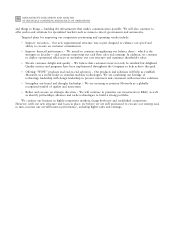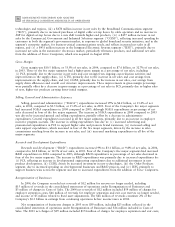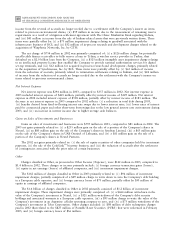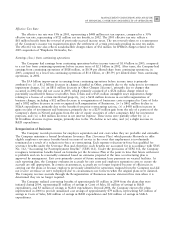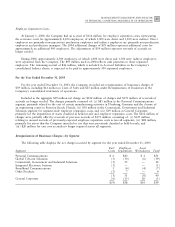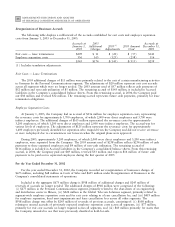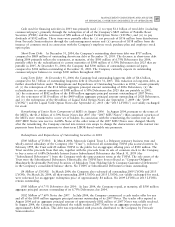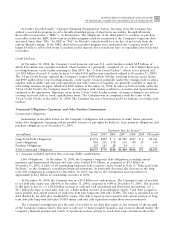Motorola 2004 Annual Report Download - page 49
Download and view the complete annual report
Please find page 49 of the 2004 Motorola annual report below. You can navigate through the pages in the report by either clicking on the pages listed below, or by using the keyword search tool below to find specific information within the annual report.
41
MANAGEMENT'S DISCUSSION AND ANALYSIS
OF FINANCIAL CONDITION AND RESULTS OF OPERATIONS
EÅective Tax Rate
The eÅective tax rate was 33% in 2003, representing a $448 million net tax expense, compared to a 35%
eÅective tax rate, representing a $721 million net tax beneÑt, in 2002. The 2003 eÅective tax rate reÖects a
$61 million beneÑt from the reversal of previously-accrued income taxes. The tax reversal relates to a reassessment
of the Company's income tax requirements given the settlement of certain previously-pending income tax audits.
The eÅective tax rate also reÖects nondeductible charges taken of $32 million for IPR&D charges related to the
2003 acquisition of Winphoria Networks, Inc.
Earnings (loss) from continuing operations
The Company had earnings from continuing operations before income taxes of $1.4 billion in 2003, compared
to a net loss from continuing operations before income taxes of $2.1 billion in 2002. After taxes, the Company had
earnings from continuing operations of $928 million, or $0.39 per diluted share from continuing operations, in
2003, compared to a loss from continuing operations of $1.4 billion, or ($0.59) per diluted share from continuing
operations, in 2002.
The $3.4 billion improvement in earnings from continuing operations before income taxes is primarily
attributed to: (i) a $1.2 billion decrease in charges classiÑed as Other, primarily due to the reduction in investment
impairment charges, (ii) an $811 million decrease in Other Charges (Income), primarily due to charges that
occurred in 2002 that did not occur in 2003, which primarily consisted of a $526 million charge related to
potentially uncollectible Ñnance receivables from Telsim and a $325 million intangible asset impairment charge
relating to a license of certain intellectual property, (iii) a $634 million decrease in overall reorganization of
business charges, including a $52 million decrease in reorganization of businesses costs recognized in Costs of Sales
and a $582 million decrease in costs recognized in Reorganization of Businesses, (iv) a $462 million decline in
SG&A expenditures, primarily due to the beneÑts from prior restructuring actions, (v) a $458 million increase in
gains on sales of investments and businesses, primarily due to a $255 million gain from the sale of a portion of the
Company's shares in Nextel and gains from the sale of equity securities of other companies held for investment
purposes, and (vi) a $61 million decrease in net interest expense. These items were partially oÅset by: (i) a
$114 million decrease in gross margin, primarily due to the 1% decline in net sales, and (ii) a slight increase in
R&D expenditures.
Reorganization of Businesses
The Company records provisions for employee separation and exit costs when they are probable and estimable.
The Company maintains a formal Involuntary Severance Plan (Severance Plan) which permits Motorola to oÅer
eligible employees severance beneÑts based on years of service in the event that employment is involuntarily
terminated as a result of a reduction-in-force or restructuring. Each separate reduction-in-force has qualiÑed for
severance beneÑts under the Severance Plan and, therefore, such beneÑts are accounted for in accordance with SFAS
No. 112, ""Accounting for Postemployment BeneÑts'' (SFAS 112). Under the provisions of SFAS 112, the Company
recognizes termination beneÑts based on formulas per the Severance Plan at the point in time that future settlement
is probable and can be reasonably estimated based on estimates prepared at the time a restructuring plan is
approved by management. Exit costs primarily consist of future minimum lease payments on vacated facilities. At
each reporting date, the Company evaluates its accruals for exit costs and employee separation costs to ensure the
accruals are still appropriate. In certain circumstances, accruals are no longer required because of eÇciencies in
carrying out the plans or because employees previously identiÑed for separation resigned from the Company and did
not receive severance or were redeployed due to circumstances not foreseen when the original plans were initiated.
The Company reverses accruals through the Reorganization of Businesses income statement line item when it is
determined they are no longer required.
The Company realized cost-saving beneÑts of approximately $5 million in 2004 from the plans that were
initiated during 2004, representing $1 million of savings in Costs of Sales, $1 million of savings in R&D
expenditures, and $3 million of savings in SG&A expenditures. Beyond 2004, the Company expects the plans
implemented in 2004 to provide annualized cost savings of approximately $79 million, representing $25 million of
savings in Costs of Sales, $22 million of savings in R&D expenditures and $32 million of savings in SG&A
expenditures.





